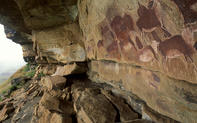Three Bushmen
A name by which the Drakensberg's southernmost mountain is known as the Three Bushmen. The cracked basalt crests sweep up from the source of the Bushman's River and from Bushman's Nek Pass, through which the last Bushmen cattle raids were conducted during the 1870s.

Sehlaba-Thebe aptly means 'the shield', as the park is a plateau, raised on a three-sided pedestal of sandstone cliffs, called the Little Berg. Along its western boundary the plateau adjoins the Drakensberg Escarpment wall. The large sandstone caves which pockets these cliffs were the homes of Bushmen clans for thousands of years, before the Difaqane wars and the subsequent arrival of white hunters and farmers squeezed them out.
However, in the caves here and throughout the Drakensberg the bushmen, often hunted down and shot as 'vermin' by settlers and adventurers, left behind a legacy of rock art which tells of their lives, their hunting-orientated mythology and their poetry, and which testifies to their great skill as artists. The fast-fading paintings are considered to be the finest collection of rock art in the world. The stylistic drawings capture the essence of moving people and animals with an unequalled grace.
The last known remaining Bushman in Natal was shot in the Giant's Castle area, shortly before a game reserve was proclaimed there to protect the Drakensberg's last eland herds. This individual was also probably their last great artist, for around his waist was found a belt of small antelope horns, stuffed with the pigments he mixed with egg white, animal fat and aloe juice, and the shredded twigs that were his brushes.